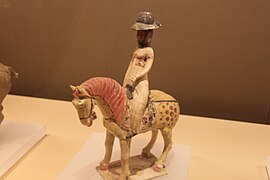|
Tanling ruqun
Tanling ruqun (Chinese: 坦领襦裙; pinyin: Tǎnlǐng rúqún; lit. 'Flat (or open-hearted) collar jacket skirt'), also known as Tan collar ruqun and U-collar ruqun,[1] is a type of Hanfu which was developed under the influence of Hufu (most likely influenced by Qiuci);[2] it is a form a kind of ruqun which typically consists of three parts, featuring a low-cut[3]: 93–94 low-cut U-shaped collar upper inner garment with long sleeves, a U-shaped collar banbi upper outer garment with short sleeves, a long high-waisted skirt.[4][2][5] It can also be adorned with a shawl, called pipo (Chinese: 披帛).[6][5] It was a popular form of clothing attire in the Sui and Tang dynasty.[2] In the 21st century, the Tanling ruqun re-appeared as a result of the Hanfu movement.[6] The 21st century Tanling ruqun was developed by reproducing the original patterns of the historical tanling ruqun while being aligned with modern aesthetics.[7] TerminologyThe term tanling ruqun is composed of the terms tanling and ruqun. Tanling (Chinese: 坦领; pinyin: Tǎnlǐng) refers to the U-shaped (Chinese: 坦; pinyin: Tǎn; lit. 'flat collar/ open-hearted') collar (Chinese: 领; pinyin: Lǐng; lit. 'Collar') of the upper garment, typically specifically referring to the U-shaped banbi which is worn as an outer upper garment.[2][8] The term ruqun refers to the traditional two piece attire of the ancient Han Chinese consisting of a skirt and an upper garment called ru.[8] Construction and designThe tanling ruqun is mainly composed three parts: a long wrap skirt, a U-shaped collar inner shirt with long sleeves, and a tanling banbi (a U-shaped short sleeves outer jacket).[4] Unearthed artefacts dating in the Tang dynasty, such as sculptures and paintings show that the long-sleeves, low-cut inner shirt could be tucked under the long (high-waisted[3]: 93 [9]: 85 ) skirts.[10]: 291 The skirts could be embellished with stripe patterns of two colours or be found in monochrome colours.[4][10]: 291 [9]: 87 The banbi falls above the waist[10]: 291 or were waist-length,[4] and they could be embellished with embroidered borders at the wrist.[10]: 291 The banbi could also be tucked under or worn over the long skirt.[4][3]: 93–94 The tanling ruqun can also be worn together with a shawl, called pipo (Chinese: 披帛), around the arms or the shoulders of its wearer;[9]: 85–86 they could also wear it together with variety of hats.[10]: 291 In the Tang dynasty, hats of foreign origins or influence, such as the mili, weimao and humao, were worn when horseback riding.[10]: 291
History The late sixth century, for example in the Sui dynasty, was marked the arrival of new style of women's Hanfu.[12]: 25 The new style of clothing had high waisted skirt almost similar to the Empire silhouette and the upper garments had low décolletage.[12]: 25 The Sui dynasty women already liked wearing banbi over their long-sleeved clothing.[13] Tanling garments, including the tanling banbi, was already popular in the court of the early Sui dynasty, the predecessor of the Tang dynasty.[14][1] The Tang dynasty continued the clothing style of its predecessor, and women continued to wear high-waisted skirt, low-cut upper garments and long skirts.[12]: 25 [15]: 184  In the early Tang dynasty up to the late 8th century,[4] banbi were also popular among women, including noble and common women.[16] According to the New Book of Tang, "banbi, skirt, and ru are common clothes for maids served at the Eastern Palace".[16] In the 7th century, palace women could wear banbi over a plain shirt and a high-waisted, A-line skirts which could be monochrome or striped.[4] In the Tang dynasty, new styles of Tanling banbi appeared and became extremely popular.[14] Some shapes of banbi (such as the tanling banbi) worn in the early Tang appears to have been mainly influenced by the banbi worn in Qiuci.[16] Figures wearing banbi and striped skirt holding a shawl (pipo) and wearing low cut upper garments appear on the murals of Kizil Grottoes in Xinjiang; the shape and matching garments customs were similar to the early Tang dynasty's women clothing attire.[16] In the first decade of the 8th century, skirts in monochrome colours became more popular than stripped skirts.[9]: 85 By the mid-Tang dynasty around the mid-8th century, upper garments with low décolletage lost popularity and women started to cover themselves with shawls; there were also new ideals of beauty favouring extremely plump and voluptuous women over the youthful slenderness of the Sui and the early Tang dynasties.[12]: 25
Other types of ruqun
See also
References
|
||||||||||||||||||||||












